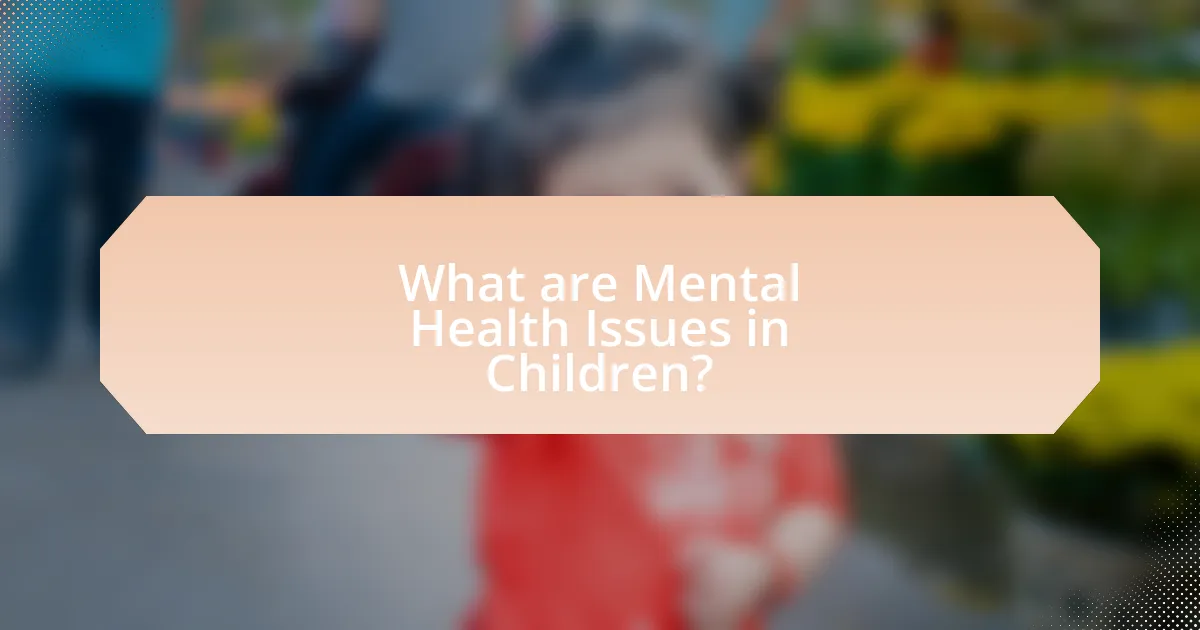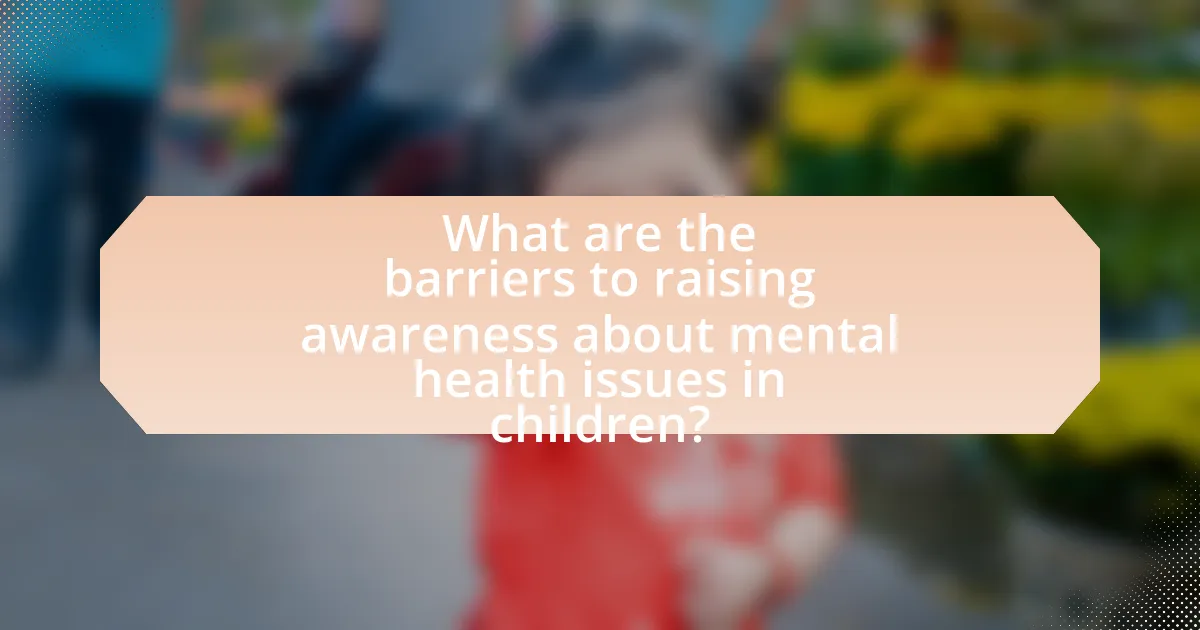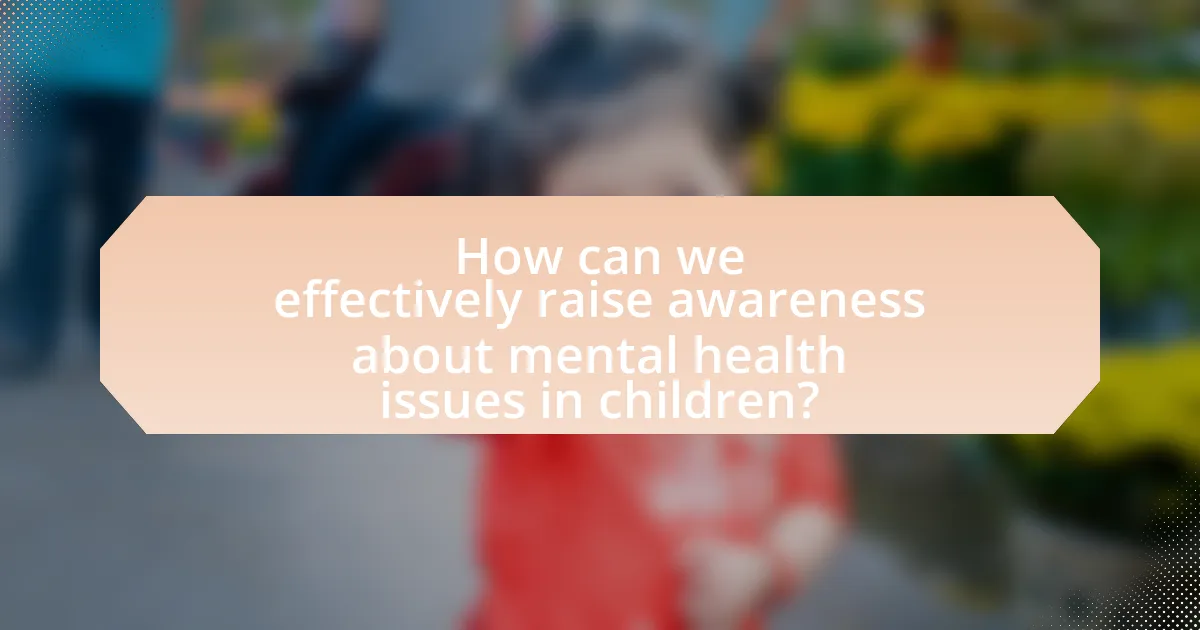Mental health issues in children encompass a variety of emotional, behavioral, and psychological conditions, including anxiety disorders, depression, ADHD, and autism spectrum disorders. Approximately 1 in 6 children aged 2 to 8 years is diagnosed with a mental health disorder, underscoring the importance of early identification and intervention to prevent long-term consequences on their development and well-being. The article explores how these issues manifest, the common signs and symptoms, and the critical role parents and educators play in recognizing and addressing mental health challenges. It also discusses the barriers to awareness, the impact of stigma, and effective strategies for promoting mental health education within communities and schools.

What are Mental Health Issues in Children?
Mental health issues in children encompass a range of emotional, behavioral, and psychological conditions that can affect their development and daily functioning. These issues include anxiety disorders, depression, attention-deficit/hyperactivity disorder (ADHD), autism spectrum disorders, and conduct disorders. According to the National Institute of Mental Health, approximately 1 in 6 children aged 2 to 8 years has a diagnosed mental health disorder, highlighting the prevalence and significance of these issues. Early identification and intervention are crucial, as untreated mental health problems can lead to long-term consequences in a child’s academic, social, and emotional well-being.
How do mental health issues manifest in children?
Mental health issues in children manifest through a variety of emotional, behavioral, and physical symptoms. Common manifestations include persistent sadness, anxiety, withdrawal from social interactions, changes in eating or sleeping patterns, and difficulty concentrating. For instance, the National Institute of Mental Health reports that approximately 1 in 6 children aged 2 to 8 years experience a mental health disorder, highlighting the prevalence of these issues. Additionally, children may exhibit behavioral problems such as aggression or defiance, which can be indicative of underlying mental health challenges. These symptoms can significantly impact a child’s daily functioning and development, necessitating early identification and intervention.
What are the common signs and symptoms of mental health issues in children?
Common signs and symptoms of mental health issues in children include persistent sadness, excessive worry, changes in behavior, and difficulty concentrating. Children may exhibit irritability, withdrawal from friends and activities, and changes in sleep or appetite. According to the National Institute of Mental Health, approximately 1 in 6 children aged 2 to 8 years old experience a mental health disorder, highlighting the prevalence of these symptoms. Early identification and intervention are crucial for effective treatment and support.
How can parents and educators identify these issues early?
Parents and educators can identify mental health issues early by observing behavioral changes, emotional responses, and social interactions in children. Regular monitoring of a child’s mood, academic performance, and relationships can reveal signs of distress, such as withdrawal, irritability, or a decline in schoolwork. Research indicates that early identification of mental health issues can lead to more effective interventions, as studies show that 50% of mental health conditions manifest by age 14. Utilizing screening tools and maintaining open communication with children can further aid in recognizing these issues promptly.
Why is it important to address mental health issues in children?
Addressing mental health issues in children is crucial because early intervention can significantly improve their overall well-being and development. Research indicates that approximately 1 in 5 children experience mental health disorders, which can lead to long-term consequences if left untreated, including academic difficulties and social challenges. By addressing these issues early, caregivers and educators can provide necessary support, leading to better emotional regulation and resilience in children. Furthermore, studies show that early treatment can reduce the risk of developing more severe mental health problems in adulthood, highlighting the importance of proactive measures in childhood mental health care.
What are the long-term effects of untreated mental health issues?
Untreated mental health issues can lead to severe long-term effects, including chronic physical health problems, impaired social functioning, and increased risk of substance abuse. Research indicates that individuals with untreated mental health conditions are more likely to experience cardiovascular diseases, diabetes, and obesity due to the stress and lifestyle factors associated with mental illness. Additionally, untreated mental health issues can result in difficulties in maintaining relationships, leading to social isolation and decreased quality of life. A study published in the Journal of the American Medical Association found that untreated mental health disorders significantly increase the likelihood of developing substance use disorders, further complicating recovery and overall well-being.
How do mental health issues impact a child’s development and education?
Mental health issues significantly hinder a child’s development and education by affecting their emotional, social, and cognitive growth. Children with mental health challenges often experience difficulties in forming relationships, regulating emotions, and maintaining focus, which can lead to poor academic performance. For instance, research published in the Journal of the American Academy of Child and Adolescent Psychiatry indicates that children with anxiety disorders are more likely to struggle with school attendance and performance, with studies showing that up to 20% of school-aged children experience mental health disorders that can disrupt their learning. Additionally, the National Institute of Mental Health reports that untreated mental health issues can lead to long-term consequences, including increased dropout rates and lower educational attainment.

What are the barriers to raising awareness about mental health issues in children?
Barriers to raising awareness about mental health issues in children include stigma, lack of education, and insufficient resources. Stigma surrounding mental health often leads to families and communities avoiding discussions about these issues, which hinders open dialogue and understanding. A lack of education among parents, teachers, and healthcare providers results in misconceptions about mental health, preventing early identification and intervention. Additionally, insufficient resources, such as funding for mental health programs and trained professionals, limits access to information and support services for children and their families. These factors collectively contribute to the challenges in promoting awareness and addressing mental health issues effectively.
How does stigma affect discussions around children’s mental health?
Stigma significantly hinders discussions around children’s mental health by creating an environment of fear and misunderstanding. This stigma often leads to parents and caregivers feeling ashamed or reluctant to seek help for their children, which can delay diagnosis and treatment. Research indicates that approximately 50% of parents believe that mental health issues in children are a sign of personal failure, which discourages open conversations and support. Furthermore, children may internalize this stigma, leading to feelings of isolation and worsening mental health conditions.
What are common misconceptions about children’s mental health?
Common misconceptions about children’s mental health include the belief that children cannot experience mental health issues, that these issues are merely phases that will pass, and that mental health problems are a result of poor parenting. Research indicates that approximately one in six children aged 2 to 8 years old has a diagnosed mental health disorder, demonstrating that children are indeed susceptible to mental health challenges. Additionally, many mental health conditions, such as anxiety and depression, can persist without appropriate intervention, contradicting the notion that they are just temporary phases. Furthermore, studies show that while parenting styles can influence a child’s mental health, many factors, including genetics and environment, contribute to these conditions, highlighting that blaming parents oversimplifies the complexities of mental health.
How can stigma be reduced in communities?
Stigma can be reduced in communities through education and open dialogue about mental health issues. Implementing community workshops and school programs that provide accurate information about mental health can foster understanding and empathy. Research indicates that educational interventions can significantly decrease stigma; for instance, a study published in the journal “Psychological Medicine” found that mental health literacy programs led to a 30% reduction in stigma among participants. Additionally, sharing personal stories from individuals with mental health experiences can humanize the issue and encourage supportive conversations, further diminishing stigma in community settings.
What role do schools play in raising awareness?
Schools play a crucial role in raising awareness about mental health issues in children by providing education, resources, and support systems. They implement programs that educate students, teachers, and parents about mental health, helping to reduce stigma and promote understanding. For instance, studies show that schools that incorporate mental health education into their curriculum can significantly improve students’ knowledge and attitudes towards mental health, leading to earlier identification and intervention for those in need. Additionally, schools often collaborate with mental health professionals to offer workshops and counseling services, further enhancing awareness and support for students facing mental health challenges.
How can school programs be designed to promote mental health awareness?
School programs can be designed to promote mental health awareness by integrating mental health education into the curriculum, providing training for teachers, and creating supportive environments. Incorporating lessons on mental health topics, such as stress management and emotional regulation, into subjects like health or social studies ensures that students receive essential information. Training teachers to recognize signs of mental health issues equips them to support students effectively, fostering a culture of understanding and empathy. Additionally, establishing peer support groups and mental health resources within schools encourages open discussions and reduces stigma. Research indicates that schools implementing comprehensive mental health programs see improved student well-being and academic performance, highlighting the effectiveness of these strategies.
What training do educators need to support children’s mental health?
Educators need training in mental health awareness, intervention strategies, and trauma-informed practices to effectively support children’s mental health. This training equips educators with the skills to recognize signs of mental health issues, implement appropriate interventions, and create a supportive classroom environment. Research indicates that educators who receive mental health training can significantly improve students’ emotional well-being and academic performance, as evidenced by a study published in the Journal of School Psychology, which found that schools implementing mental health training saw a 20% decrease in behavioral issues among students.

How can we effectively raise awareness about mental health issues in children?
To effectively raise awareness about mental health issues in children, it is essential to implement educational programs in schools that focus on mental health literacy. Research indicates that early education on mental health can significantly reduce stigma and promote understanding among children. For instance, a study published in the Journal of the American Academy of Child and Adolescent Psychiatry found that school-based mental health programs improved students’ knowledge and attitudes towards mental health issues. Additionally, engaging parents through workshops and community events can further enhance awareness and support systems for children.
What strategies can be implemented to promote mental health awareness?
To promote mental health awareness, educational programs targeting children and their caregivers can be implemented. These programs should focus on teaching the signs of mental health issues, coping strategies, and the importance of seeking help. Research indicates that early intervention can significantly improve outcomes; for instance, a study published in the Journal of the American Academy of Child & Adolescent Psychiatry found that mental health education in schools leads to increased help-seeking behavior among students. Additionally, community campaigns utilizing social media and local events can effectively reach a broader audience, fostering open discussions about mental health and reducing stigma.
How can social media campaigns be utilized for awareness?
Social media campaigns can be utilized for awareness by creating targeted content that engages specific audiences about mental health issues in children. These campaigns can leverage platforms like Facebook, Instagram, and Twitter to disseminate information, share personal stories, and promote resources, thereby reaching a wider demographic. For instance, a study by the Pew Research Center found that 69% of adults in the U.S. use social media, making it an effective channel for spreading awareness. Additionally, using hashtags and interactive elements, such as polls or live Q&A sessions, can enhance engagement and encourage community discussions around mental health topics.
What community resources are available to support mental health education?
Community resources available to support mental health education include local mental health organizations, schools, and community centers that offer workshops and training programs. For instance, the National Alliance on Mental Illness (NAMI) provides educational programs specifically designed for families and individuals to understand mental health issues. Additionally, many schools implement social-emotional learning curricula that educate children about mental health, fostering awareness and reducing stigma. Community centers often host support groups and informational sessions that promote mental health literacy among parents and children. These resources are crucial in raising awareness about mental health issues in children and equipping families with the knowledge they need.
What are some best practices for parents and caregivers?
Best practices for parents and caregivers include fostering open communication, establishing routines, and promoting emotional literacy. Open communication allows children to express their feelings and concerns, which is essential for mental health. Establishing routines provides children with a sense of stability and security, reducing anxiety. Promoting emotional literacy helps children recognize and articulate their emotions, leading to better emotional regulation. Research indicates that children who can identify their emotions are more likely to develop healthy coping strategies (Denham et al., 2012, “Emotional Intelligence in Children”). These practices collectively contribute to a supportive environment that enhances children’s mental well-being.
How can parents initiate conversations about mental health with their children?
Parents can initiate conversations about mental health with their children by creating a safe and open environment for discussion. This can be achieved by regularly asking children how they feel and actively listening to their responses without judgment. Research indicates that children who feel comfortable discussing their emotions are more likely to seek help when needed, as highlighted in a study published in the Journal of Child Psychology and Psychiatry, which found that open communication significantly reduces stigma around mental health issues. Additionally, parents can share their own experiences with emotions and mental health, modeling vulnerability and encouraging children to express their feelings.
What resources can parents use to educate themselves and their children?
Parents can use various resources to educate themselves and their children about mental health issues. These resources include books such as “The Whole-Brain Child” by Daniel J. Siegel and Tina Payne Bryson, which provides insights into child development and emotional well-being. Online platforms like the National Alliance on Mental Illness (NAMI) offer educational materials and support for families dealing with mental health challenges. Additionally, workshops and seminars provided by local mental health organizations can enhance understanding and coping strategies. Research indicates that informed parents are better equipped to support their children’s mental health, as evidenced by studies showing improved outcomes in children whose parents engage in mental health education.
What practical steps can communities take to support mental health awareness?
Communities can support mental health awareness by organizing educational workshops and seminars that focus on mental health issues, particularly those affecting children. These events can provide valuable information on recognizing signs of mental health struggles, promoting early intervention, and reducing stigma. Research indicates that community-based programs, such as the National Alliance on Mental Illness (NAMI) initiatives, have effectively increased awareness and understanding of mental health issues, leading to improved support systems for affected individuals. Additionally, communities can collaborate with schools to implement mental health curricula, ensuring that children receive age-appropriate education on emotional well-being and coping strategies.
How can local organizations collaborate to promote mental health initiatives?
Local organizations can collaborate to promote mental health initiatives by forming partnerships that leverage shared resources, expertise, and community outreach efforts. For instance, schools, healthcare providers, and non-profits can work together to create awareness campaigns, workshops, and support groups tailored to children’s mental health needs. Research indicates that collaborative approaches can enhance the effectiveness of mental health programs; a study published in the Journal of Community Psychology found that community coalitions significantly improved mental health outcomes by pooling resources and knowledge. By coordinating efforts, local organizations can ensure a more comprehensive and impactful approach to addressing mental health issues in children.
What events can be organized to engage the community in mental health discussions?
Community forums can be organized to engage the community in mental health discussions. These forums provide a platform for open dialogue, allowing participants to share experiences and learn from mental health professionals. Research indicates that community engagement in mental health topics can reduce stigma and increase awareness, as seen in initiatives like the National Alliance on Mental Illness (NAMI) which reports that community discussions lead to improved understanding of mental health issues. Additionally, workshops and seminars focused on mental health education can further facilitate these discussions, providing valuable resources and support for families and children.